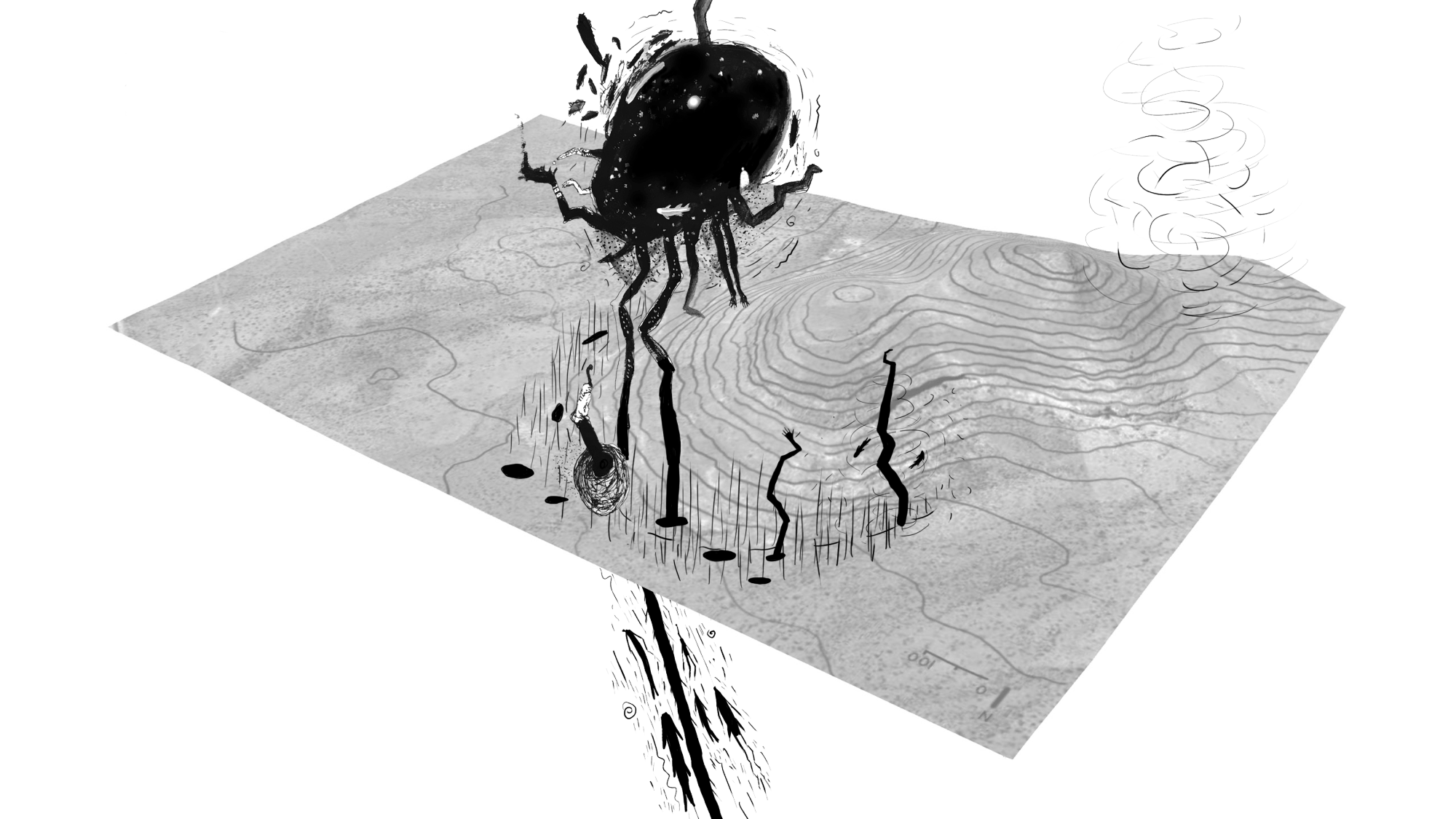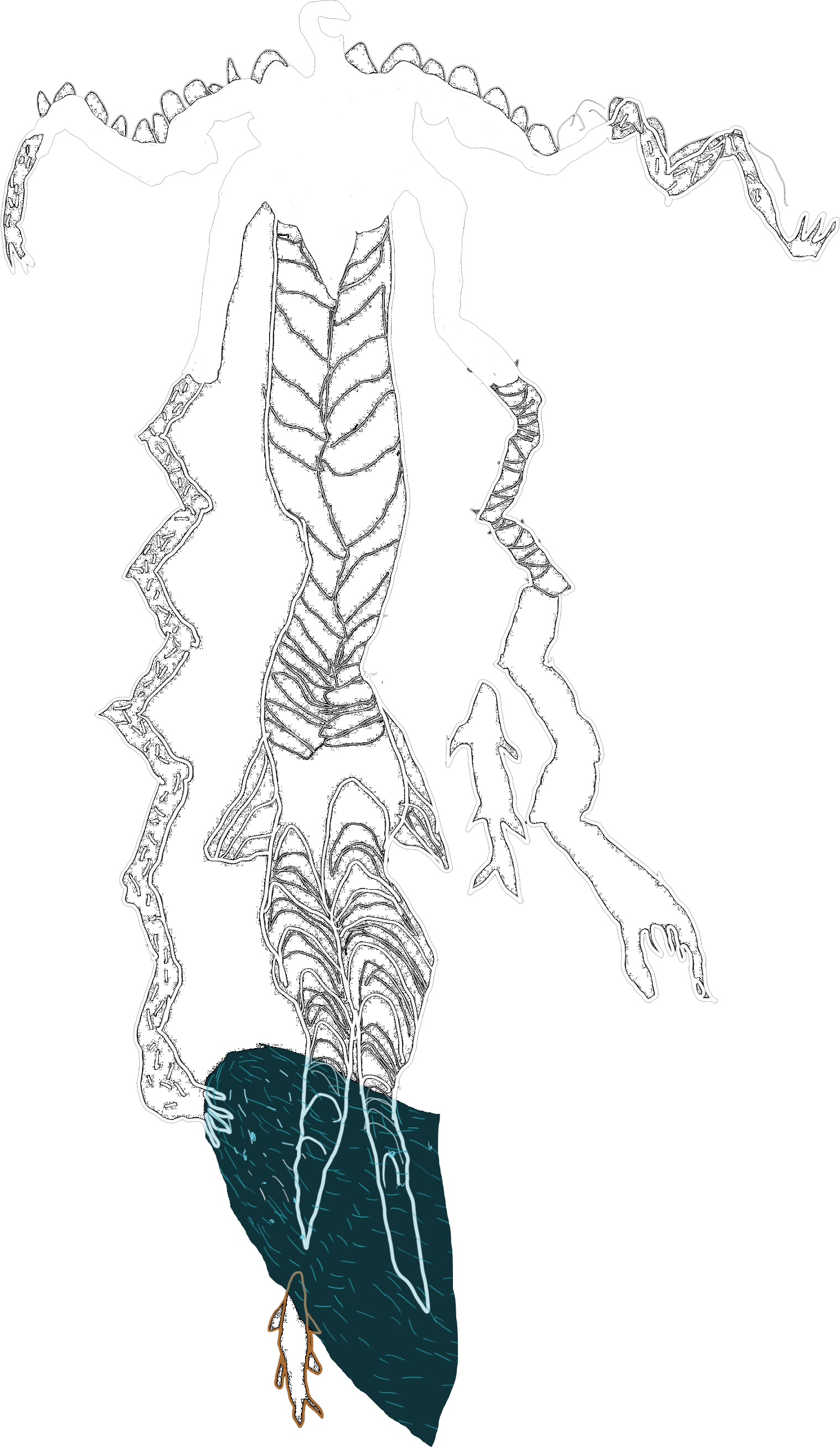Ga-Mohana Hill and rock shelters are located just outside of the town of Kuruman, in the Northern Cape province of South Africa. Sitting on the edge of the Kalahari Basin, this hill protrudes from a dead flat landscape a billion years old. Some of the oldest rock formations and signs of the beginning of oxygen-breathing life have been found here along with evidence of human occupation stretching back 100 000 years ago, around the start of modern human behavior. The rock shelters have been persistent places for thousands of years and are still in use today in the stories, cultures and religions of people in the local community.
This 3D visualisation of Ga-Mohana Hill, Kuruman, South Africa, was created as a collaborative effort with the intention of representing the multiple uses and beliefs associated with the hill and rock shelters. Myths of the Great Snake, Noga ya Metsi, are associated with the hill, and some people in the local community regard the place with mystery, secrecy and fear. Church groups use the hill and shelters for prayer sessions. We know that Ga-Mohana Hill was used by people 105,000 years ago because the sediments in this rockshelter were excavated by a team of archaeologists. It is our aim to create an authentic manifestation of Ga-Mohana in the digital realm, while paying tribute to it as a Persistent Place.
Persistent Place:
A dwelling place that is used repeatedly over long periods of occupation.
They provide a structure where identities are formed and relationships are created during the performing of tasks and cultural practices.
They are places where memory and affection cast them as places of deep meaning.

Dr Sechaba Maape
"From a very young age people in Kuruman are told stories about a mythical snake. It is known to be the cause of natural forces like whirlwinds, responsible for environmental calamities, lost people, and other tragic situations. In my own life I was told about the snake primarily because of its tendency to abduct people with particular bodily features. I was told that the snake takes people with connected eyebrows, which I happen to have. Some of my earliest memories are of being told that the snake was going to take me because of the shape of my eyebrows. It turns out that this is in fact an ancient tradition connected to female initiation. The snake is known to be attracted to people with interlocking eyebrows and beauty spots because it itself shares these features. It is strange in form and character, travels along underwater rivers and channels, is known to shapeshift and tricks its victims, and is especially associated with “taking” people to specific places, especially water bodies and caves.
One story is that of a young girl herding sheep who is suddenly overcome by thirst. She is drawn to a nearby waterhole, and as she draws closer, she hears the voice of a child. She goes closer still and sees that there is a small child’s hand reaching out from under the water, but the water is dark, and the rest of the body is not visible. When the girl reaches to help the child, the hand, which she now realizes belongs to the terrible snake, pulls her down into the water. Being taken, unlike willingly giving yourself up, involves the relinquishment of personal agency. I was warned that the snake would take me because my eyebrows were interlinked, something over which I have no control, similar to the way the girl had no control over her thirst: it stole her agency. Change is forced on those who meet and are abducted by the snake, becoming a kind of grace, invoked through ritual as, ultimately,
In my youth, though less so today, we were forbidden to go to particular parts of the landscape primarily because these are the places where the snake resides, dangerous for people like me, with my snake-like features. Caves and water bodies in general, and specific caves known to be the dwelling place of the snake in particular, are seen by some in the community as frightening. People sometimes avoid crossing a stream or entering a particular space associated with the snake.
The Ga-Mohana rock shelters, located on a remote hill away from the nearest settlement, have also been associated with initiation rituals, but for boys rather than girls, and much less so now than in the past. Yet I was still told about Go-Mohana in my formative years, and as far back as I can remember it was where the snake resided. In both places, initiates would have to cross mythical boundaries associated with the snake, facing a lifelong and well-established fear as part of their ritual process."
Except taken from - Sechaba Maape. (2021). Drawing creepy places: Representing liminal ritual spaces in Kuruman, South Africa. Dialectic, 9(Decolonizing), 2–12.
Dr Sechana Maape is a Architecture lecturer at Wits University. He has done extensive research into indigenous belief and ritual in Kuruman, where he grew up


The two main shelters of Ga-Mohana are not easily visible from afar. To enter the north shelter requires a steep walk from the base of the hill. There are no signposts or other infrastructure to help visitors find their way or learn about the place. The shelters are therefor hidden from public view. The north shelter reveals itself fully only upon entering the long and wide overhang. The horizontal layered rock create flowing contours which form a deep, tall bowl at the shelters apex. Most cultural activities have gravitated to this central location, probably because of the grand atmosphere that is naturally created by this cavern. Fireplaces, candles and bedding are often found here, and one can imagine the stories that this unique setting has inspired. Cultural activities have been performed at this location stretching back in deep time. A diverse community uses Ga-Mohana Hill today for various activities including initiation, tourism, religion and traditional healing.
The archaeology of Ga-Mohana Hill reveals how important this place was over the last 100,000 years.
An international and inter-disciplinary team that includes researchers and students from South Africa, Australia, UK, Austria, and Canada, have been studying Ga-Mohana Hill since 2016. Archaeological excavations have recovered ancient stone tools, animal bones, ostrich eggshell, and crystals from the sediments inside the rock shelters, the oldest of which date back to 105 000 years ago.
The digitised artefacts shown below were excavated from Ga-Mohana North Rockshelter, and came from Area A as can be seen in the image below.

Ancient ancestors brought many calcite crystals to Ga-Mohana 105,000-years-ago. This is just 1 of the 22 crystals that have been found. Crystals hold spiritual significance for many cultures around the world.
The crystals show us that there is a long history of spiritual and ritual activity at Ga-Mohana Hill. Perhaps some of the factors that make Ga-Mohana Hill a special place today were also recognized by the ancestors that lived in this area 105,000-years-ago.
25 mm max length
The ancestors that used Ga-Mohana Hill 105,000-years-ago made and used stone tools for their day-to-day activities. Stone tools have very sharp edges and function well for hunting and butchering, processing foraged plant foods, and scraping hides to make leather.
Tools like this one shown here are called “blades” and require special know-how and skill to make.
Some types of stone are better for making stone tools than others. There are very good quality stone types at and around Ga-Mohana Hill, which may have been one of the reasons that people chose to stay in the shelters here.
94 mm max length
Ostrich eggshell fragments show that people collected and used ostrich eggs at Ga-Mohana. Ostrich eggs make excellent water storage containers.
In February 2021 Sechabe Maape and I (Stephen Wessels) visited Ga-Mohana hill to 3D photo-scan the Hill, surrounding landscape and the two main shelters. We battled through heat, and locusts, and found the landscape in a very lush green state. During the fieldwork we encountered people preparing cultural dishes in potjie pots, ecstatically praying at the top of the Hill, and sleeping in the shelter.
The 3D model of Ga-Mohana Hill and shelters was created by photogrammetry using a drone and hand-held camera. Photogrammetry is the process of extracting 3D information from overlapping photos taken in a specific manner.
An area of size 1.8km x 1.5km was recorded which required 1600 orthographic drone images, 1150 oblique drone images, and 1500 hand-held images. Capturing the entire hill required flying the drone in an autonomous grid pattern with the drone camera pointing straight down (orthographic).
Accurate GPS points were taken to scale, level and fit the model to the already established co-ordinate system at Ga-Mohana set up by the archaeological team.
Once all the photogrammetry and GPS data has been captured there is a long process to get to the online 3D model. Images need to be pre-processed to colour balance and adjust for white balance, aligned, 3D information extracted in the form of a triangulated mesh, and colour projected back onto the mesh. This results in a raw model which is then reduced in detail from 100's of millions of triangles to a few million. Then the model is cleaned, and optimised for the web.
During the COVID-19 lockdown in South Africa travel was restricted which meant student field trips were not possible. Architecture students at Wits University virtually visited Ga-Mohana Hill using the 3D visualisation to create their own interpretations of life at Ga-Mohana Hill.
Using the 3D model as a backdrop, every unique view of the shelters can be obtained. This is a powerful tool for visualising the place, along with or instead of, field trips.